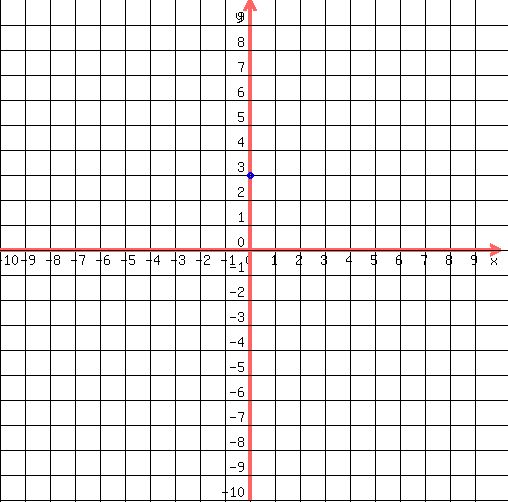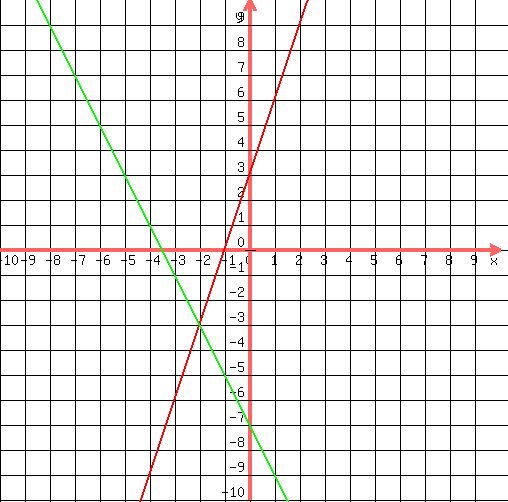|
Question 199610This question is from textbook intermediate algebra
: 3x-y=-3
2x+y=-7
i am trying to figure out how to find the x,y,xy corrdinates so i can graph the equation to find out this problem has one solution, no solution, or infininate solutions
This question is from textbook intermediate algebra
Found 2 solutions by jim_thompson5910, vleith:
Answer by jim_thompson5910(35256)   (Show Source): (Show Source):
You can put this solution on YOUR website! Start with the given system of equations:

In order to graph these equations, we must solve for y first.
Let's graph the first equation:
 Start with the first equation. Start with the first equation.
 Subtract Subtract  from both sides. from both sides.
 Divide both sides by Divide both sides by  to isolate to isolate  . .
 Rearrange the terms and simplify. Rearrange the terms and simplify.
Looking at  we can see that the equation is in slope-intercept form we can see that the equation is in slope-intercept form  where the slope is where the slope is  and the y-intercept is and the y-intercept is 
Since  this tells us that the y-intercept is this tells us that the y-intercept is ) .Remember the y-intercept is the point where the graph intersects with the y-axis .Remember the y-intercept is the point where the graph intersects with the y-axis
So we have one point )

Now since the slope is comprised of the "rise" over the "run" this means

Also, because the slope is  , this means: , this means:

which shows us that the rise is 3 and the run is 1. This means that to go from point to point, we can go up 3 and over 1
So starting at ) , go up 3 units , go up 3 units

and to the right 1 unit to get to the next point )

Now draw a line through these points to graph 
 So this is the graph of So this is the graph of  through the points through the points ) and and )
----------------------------------------------------------------------------------------
Now let's graph the second equation:
 Start with the second equation. Start with the second equation.
 Subtract Subtract  from both sides. from both sides.
 Rearrange the terms and simplify. Rearrange the terms and simplify.
Looking at  we can see that the equation is in slope-intercept form we can see that the equation is in slope-intercept form  where the slope is where the slope is  and the y-intercept is and the y-intercept is 
Since  this tells us that the y-intercept is this tells us that the y-intercept is ) .Remember the y-intercept is the point where the graph intersects with the y-axis .Remember the y-intercept is the point where the graph intersects with the y-axis
So we have one point )

Now since the slope is comprised of the "rise" over the "run" this means

Also, because the slope is  , this means: , this means:

which shows us that the rise is -2 and the run is 1. This means that to go from point to point, we can go down 2 and over 1
So starting at ) , go down 2 units , go down 2 units

and to the right 1 unit to get to the next point )

Now draw a line through these points to graph 
 So this is the graph of So this is the graph of  through the points through the points ) and and )
----------------------------------------------------------------------------------------
Now let's graph the two equations together:
 Graph of Graph of  (red). Graph of (red). Graph of  (green) (green)
From the graph, we can see that the two lines intersect at the point ) . So the solution to the system of equations is . So the solution to the system of equations is ) . .
This means that the system has one unique solution.
This also tells us that the system of equations is consistent and independent.
Answer by vleith(2983)   (Show Source): (Show Source):
You can put this solution on YOUR website!
| Solved by pluggable solver: Solving a System of Linear Equations by Elimination/Addition |
Lets start with the given system of linear equations


In order to solve for one variable, we must eliminate the other variable. So if we wanted to solve for y, we would have to eliminate x (or vice versa).
So lets eliminate x. In order to do that, we need to have both x coefficients that are equal but have opposite signs (for instance 2 and -2 are equal but have opposite signs). This way they will add to zero.
So to make the x coefficients equal but opposite, we need to multiply both x coefficients by some number to get them to an equal number. So if we wanted to get 3 and 2 to some equal number, we could try to get them to the LCM.
Since the LCM of 3 and 2 is 6, we need to multiply both sides of the top equation by 2 and multiply both sides of the bottom equation by -3 like this:
 Multiply the top equation (both sides) by 2 Multiply the top equation (both sides) by 2
 Multiply the bottom equation (both sides) by -3 Multiply the bottom equation (both sides) by -3
So after multiplying we get this:


Notice how 6 and -6 add to zero (ie  ) )
Now add the equations together. In order to add 2 equations, group like terms and combine them


 Notice the x coefficients add to zero and cancel out. This means we've eliminated x altogether. Notice the x coefficients add to zero and cancel out. This means we've eliminated x altogether.
So after adding and canceling out the x terms we're left with:

 Divide both sides by Divide both sides by  to solve for y to solve for y
 Reduce Reduce
Now plug this answer into the top equation  to solve for x to solve for x
 Plug in Plug in 
 Multiply Multiply
 Subtract Subtract  from both sides from both sides
 Combine the terms on the right side Combine the terms on the right side
 Multiply both sides by Multiply both sides by  . This will cancel out . This will cancel out  on the left side. on the left side.
 Multiply the terms on the right side Multiply the terms on the right side
So our answer is
 , , 
which also looks like
( , ,  ) )
Notice if we graph the equations (if you need help with graphing, check out this solver)


we get
 graph of graph of  (red) (red)  (green) (hint: you may have to solve for y to graph these) and the intersection of the lines (blue circle). (green) (hint: you may have to solve for y to graph these) and the intersection of the lines (blue circle).
and we can see that the two equations intersect at ( , , ). This verifies our answer. ). This verifies our answer. |
|
|
|
| |